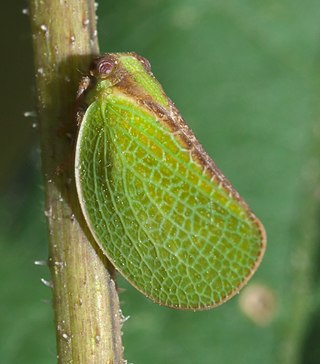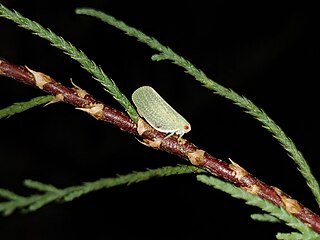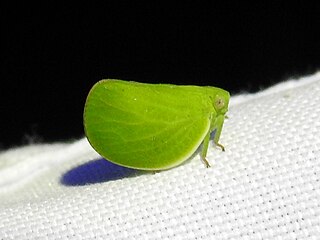
A planthopper is any insect in the infraorder Fulgoromorpha, in the suborder Auchenorrhyncha, a group exceeding 12,500 described species worldwide. The name comes from their remarkable resemblance to leaves and other plants of their environment and that they often "hop" for quick transportation in a similar way to that of grasshoppers. However, planthoppers generally walk very slowly. Distributed worldwide, all members of this group are plant-feeders, though few are considered pests. The infraorder contains only a single superfamily, Fulgoroidea. Fulgoroids are most reliably distinguished from the other Auchenorrhyncha by two features; the bifurcate (Y-shaped) anal vein in the forewing, and the thickened, three-segmented antennae, with a generally round or egg-shaped second segment (pedicel) that bears a fine filamentous arista.

The Cixiidae are a family of fulgoroid insects, one of many families commonly known as planthoppers, distributed worldwide and comprising more than 2,000 species from over 150 genera. The genera are placed into three subfamilies, Borystheninae, Bothriocerinae and Cixiinae with sixteen tribes currently accepted in Cixiinae.

Acanalonia is a genus of planthopper in the fulgorid family Acanaloniidae.

Flatidae are a family of fulgoroid planthoppers. They are cosmopolitan in distribution and are distinguished from others in the superfamily by a combination of characters. Like all other planthoppers, they suck phloem sap of plants. Some species are known to communicate with vibrations through the plant stems. Communication may be with mates, or with ants that tend the nymphs, protecting them and gathering honeydew secretions. Adults of some species have brightly coloured forewings which are tougher and known as tegmina unlike the membranous hindwings which are used for flight. Although a few can be identified by their coloration, most species requires dissection and examination under a microscope with access to literature on already described species.

Nogodinidae is a family of planthoppers. They have membranous wings with delicate venation and can be confused with members of other Fulgoroid families such as the Issidae and Tropiduchidae. Some authors treat it as a subfamily of the Issidae. Some of their key features are a frons ("face") that is longer than wide and a reticulate wing venation. They are less than 2 cm long. The antenna arises well below the eye, has the base clubbed and flagellum unsegmented. The lateral ocelli are outside the margins of the face. The face has carinae on the edge. On the hind leg, the second tarsal segment has an apical spine arising from it. The tibia of the hind leg also has spines towards the tip. An important family character is found in the shape of the male genital structure, a style that is longer than broad. Most members of this family are forest species.
Cacama carbonaria is a species of cicada in the family Cicadidae. It lives in Central America.

Achilidae is a family of planthoppers, sometimes called "achilids" in the order Hemiptera. There are at least 520 described species in Achilidae.

Aplos is a genus of issid planthopper with only one species, Aplos simplex. It can be found in most of the Eastern United States and is now found as an invasive species in Northern Italy and Austria. Aplos simplex was formerly listed under the genus Thionia.
Pterotus is a genus of fireflies in the beetle family Lampyridae. There are at least two described species in Pterotus.

Acanaloniidae is a family of planthoppers. It is sometimes treated as a subfamily of Issidae.

Acanalonia conica is a species of acanaloniid planthopper in the family Acanaloniidae. It is found in North America and Europe.

Acanalonia bivittata, the two-striped planthopper, is a species of planthopper in the family Acanaloniidae, and the most common and widespread member of the genus Acanalonia. Adults of this species are typically green, though occasionally pink. There is a reddish stripe on the inner edge of the wing.

Acanalonia servillei is a species of planthopper in the family Acanaloniidae. It is a widely distributed species, being found along the East Coast and Gulf Coast of the United States as far southwest as Texas and as far north as New York. It is also found on many Caribbean islands such as The Bahamas, Cuba, Hispaniola, and Jamacia. Like most planthoppers, it feeds on the sap of plants. It is noted as being associated with Capparis cynophallophora along with other plants in the caper family, though not exclusively. It is a quite large species for its family, usually measuring more than 9mm.

Acanalonia chloris is a species of planthopper in the family Acanaloniidae. It can be found in northern Argentina, Chile, and Uruguay.

Acanalonia fasciata is a species of planthopper in the family Acanaloniidae. It can be found in the Southwestern United States and northwestern Mexico. Possible predators include several local species of dryinid wasp. It is a smaller species with a length varying from 4.2 to 6.2 mm. It is often confused with Acanalonia bivittata, but can be differentiated by its smaller size, lack of reticulation on the base of its elytra, and by its range being farther west.

Acanalonia clypeata is a species of planthopper in the family Acanaloniidae. It can be found in the Southwestern United States. It can be found feeding on many plants including but not limited to tumbleweed, four-wing saltbush, baccharises, and Prosopis. It is approximately 7 mm long and 3 mm wide.

Acanalonia immaculata is a species of planthopper in the family Acanaloniidae. It can be found in southern New Mexico and Mexico. It is predated by dryinid wasps such as Apterodryinus torvus.A. immaculata can grow to 6.3 to 7.2 mm long.

Acanalonia virescens is a species of planthopper in the family Acanaloniidae. It is found in coastal regions such as southern coastal Texas, the east cost of Mexico, and as far south as Panama. It was initially recorded in Florida, but has not been found there since.

Acanalonia invenusta is a species of planthopper in the family Acanaloniidae. It is found in New Mexico, Texas, and northern Mexico. It is quite visually similar to Acanalonia similis, though the two can be differentiated by A. invenusta having less prominent reticulation across its elytra. It measures 4.2 - 5.6 mm.

Acanalonia similis is a species of planthopper in the family Acanaloniidae. It is found in Texas, New Mexico, and Arizona. It is quite visually similar to Acanalonia invenusta, but though the two can be differentiated as A. similis has more prominent reticulation across its elytra than A. invenusta. A. similis measures 4.2 - 4.9 mm long.

















